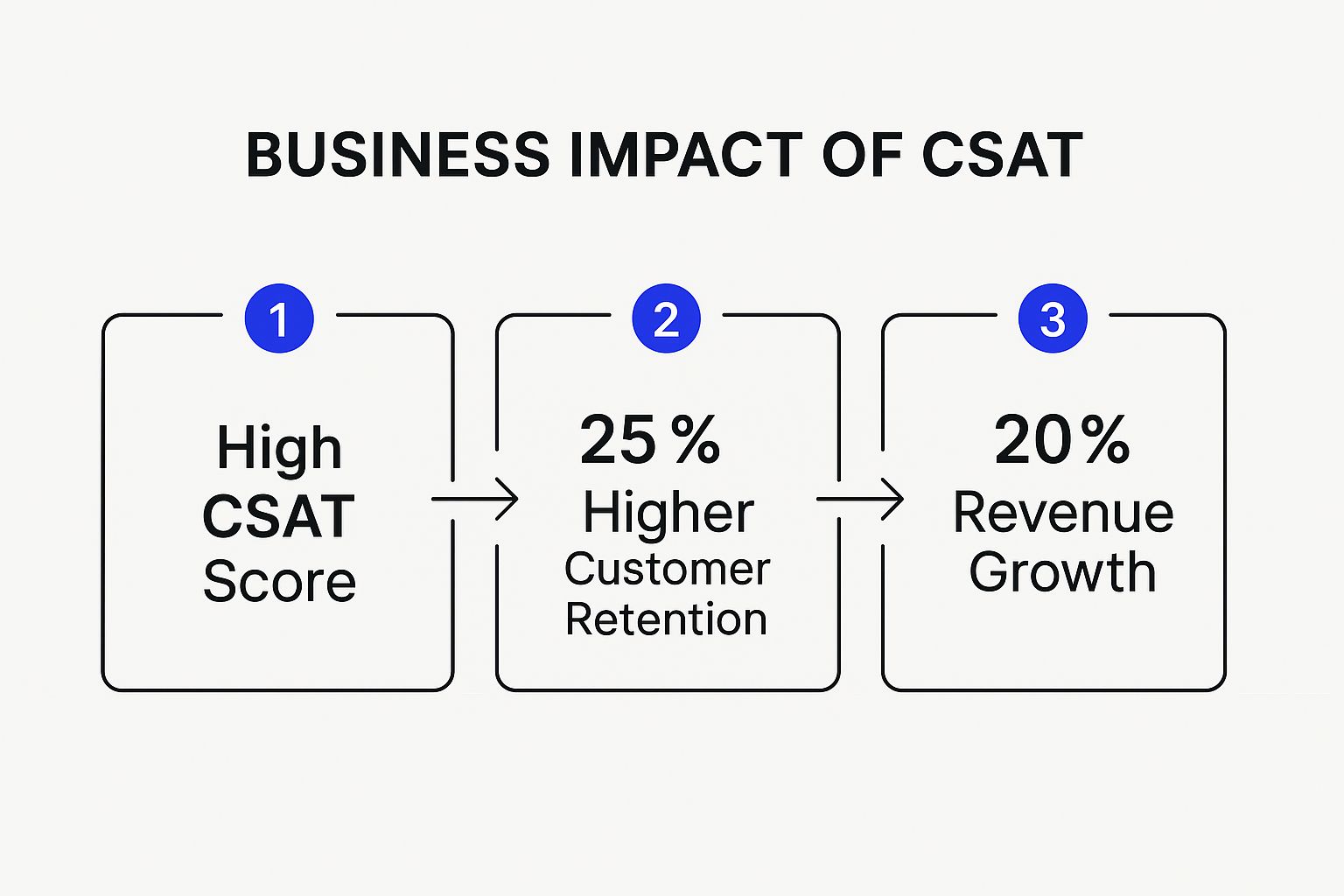How to Improve CSAT and Boost Customer Loyalty
Discover how to improve CSAT with proven, actionable strategies. This guide covers how to streamline support and use feedback to increase customer satisfaction.

So you want to improve your CSAT score? Good. You’re already asking the right questions.
The short answer is to build a system that focuses on three things: communicating proactively, delivering faster support, and actually doing something with the feedback you collect. Getting these fundamentals right is the secret to building lasting customer satisfaction and loyalty.
Why CSAT Is Your Business's North Star
Let's be clear: a high Customer Satisfaction (CSAT) score is a direct reflection of your company's overall health.
When your customers are happy, they stick around. They spend more. They become your best salespeople. In fact, research has shown that just a 5% bump in customer retention can boost profits by more than 25%.
Think of CSAT as a powerful leading indicator for your business's future. It gives you a real-time pulse on how well your product and your team are meeting customer expectations.
The Real-World Impact of a High CSAT Score
Happy customers are your best marketing channel. Positive word-of-mouth is priceless, and it all starts with delivering experiences that make people feel great about choosing you.
For SaaS companies, a high CSAT score usually translates to some tangible benefits:
- Better Customer Retention: Satisfied users don't go looking for alternatives. They’ve found a tool that solves their problem and feel like you have their back.
- Increased Loyalty and Advocacy: Truly loyal customers become your champions. They'll recommend you in their networks, write glowing reviews, and offer up great feedback.
- Healthier Revenue: A loyal customer base creates predictable revenue. They're also the first ones to upgrade their plans or try out that new feature you just launched.
This infographic really drives home the point, showing the direct line from customer satisfaction to serious business growth.

As you can see, improving satisfaction is the fuel for retention, which in turn drives revenue.
To help you get started, we've put together a quick overview of the core areas that will give you the most value when it comes to improving your CSAT score.
| Key Pillars for Improving CSAT || :--- | :--- | :--- || Strategy Area | Primary Goal | Expected Impact || Proactive Communication | Address potential issues before they become problems for the customer. | Reduces support tickets, builds trust, and shows you care. || Speed of Support | Decrease the time it takes to resolve customer inquiries. | Higher satisfaction ratings, less customer frustration. |
| Feedback Implementation | Systematically review and act on the feedback you receive. | Improved product, customers feel heard and valued. || Team Empowerment | Give your support team the tools and autonomy to solve problems. | Faster resolutions, more personalized and effective support. |
Focusing on these pillars provides a solid framework for making real, sustainable improvements.
For more information, you can explore some proven strategies to improve customer satisfaction that will help take your business to the next level. Remember, CSAT is just one piece of the puzzle. It's smart to track other key customer success metrics to get a complete picture of your performance.
Streamline Your Support for Faster Resolutions
When a customer has a problem, the clock starts ticking. One of the most direct ways to boost CSAT is to shrink the time it takes to find a solution. No one enjoys being left in limbo, and fast, effective support shows customers you respect their time.
This means taking a hard look at your entire support process. You need to find opportunities to be quicker without ever sacrificing quality.

The financial incentive is clear. Companies that deliver faster response times and more consistent support see a 2–5% increase in revenue from existing customers. On top of that, they achieve a 10–15% improvement in customer retention, which is directly tied to higher satisfaction scores. You can see more numbers with these CSAT benchmarks on fullview.io.
Eliminate Workflow Bottlenecks
First things first, map out your support journey. Look at everything from the moment a ticket is created to when it’s marked as resolved. Where do things slow down?
A classic bottleneck is ticket escalation. If a front-line agent can’t solve an issue, how long does it take for the right expert to get involved? Is it minutes, hours, or even days?
Another area to watch is information gathering. If your agents are constantly having to ask customers for the same basic details, like their subscription level or recent activity, you've found another bottleneck. Integrating your support tools with your CRM can put this information right at your agents’ fingertips from the get-go.
Key Takeaway: A support workflow audit is your best first step. Identify every point of friction or delay and ask a simple question: "How can we make this step faster and easier for both the customer and our team?"
Use Automation for Common Questions
Let's be honest, a lot of support queries are repetitive. Questions about billing, password resets, or basic feature usage can eat up a huge chunk of your agents' time. This is where smart automation becomes a real game-changer.
Think about setting up a chatbot or an automated response system that can instantly handle these frequent questions. This frees up your human agents to focus on more complex issues that require critical thinking and a human touch.
You can also build out a robust knowledge base or FAQ section that allows users to find answers on their own. In fact, 77% of customers report feeling more positive about a brand that offers solid self-service support options.
Gather and Analyze Customer Feedback Effectively
If you want to know how to improve CSAT, you have to start by listening. The only way to boost customer satisfaction is to first figure out where it’s falling short, and that means getting honest feedback directly from your users. This is about more than just sending out a generic annual survey.

Truly effective feedback collection is both timely and contextual. You need to meet the customer right where they are, at the moment that matters most.
- Post-Interaction Surveys: The best time to ask for feedback is right after an interaction. Trigger a quick CSAT survey immediately after a support ticket is closed or a chat conversation ends. This gives you an instant pulse on the quality of your service.
- In-App Feedback Widgets: Let users share their thoughts without ever leaving your product. A simple, non-intrusive widget allows them to report a bug or suggest a feature while the idea is still fresh.
- Support Conversation Analysis: Your support transcripts are a goldmine. Don't just look at survey scores; look into the actual conversations to find recurring user frustrations and product gaps.
Remember, collecting all this data is just step one. The real magic happens when you turn that raw feedback into clear, actionable insights. Simply knowing your score won't change a thing. You have to figure out the "why" behind it.
Turn Raw Data into Actionable Insights
Once you have a steady stream of feedback coming in, the real work begins: making sense of it all. Without proper analysis, you're just collecting noise. The goal is to spot the patterns so you can prioritize what to fix first.
Start by segmenting the feedback you receive. This is how you pinpoint specific problems that might be hitting different groups of users. For instance, you could organize feedback by:
- Customer Type: Are new users getting tripped up during onboarding while your power users are asking for advanced features?
- Feature Usage: Which specific parts of your product are generating the most negative feedback?
- Issue Category: Are most of the complaints about bugs, billing issues, or general usability?
This targeted approach helps you focus your limited resources on the changes that will have the biggest positive impact on your users' experience. Instead of guessing, you're making data-driven decisions.
This whole process can feel a bit overwhelming, but there are straightforward methods you can follow. To learn more, check out our complete guide on how to analyze survey data and get the most from your efforts.
Act on Feedback and Close the Loop
Collecting customer feedback is great, but it's only half the battle. The real magic happens when you use that information to make tangible improvements, and then let your customers know you did.
This is what’s known as “closing the feedback loop,” and it's one of the most powerful ways to show users you're genuinely listening.
If you just let all that valuable data sit there collecting dust, the entire process becomes pointless. Even worse, it can leave customers feeling ignored, which is a surefire way to send your CSAT scores plummeting. The trick is to build a system that turns those suggestions into real-world action.
You can start by prioritizing what comes in. Let's be honest, not every suggestion is going to be feasible or align with your product roadmap. Look for the patterns. Group similar feedback together to spot common themes. If 20% of users are all hitting the same bug or asking for the same feature, that's your cue to move it to the top of the list.
Let Them Know You’re Listening
Once you've rolled out a change based on what your users told you, it's time to communicate it. This is the "closing the loop" part that so many companies completely miss, but it has a massive impact on how customers see you.
Don't just bury the update in a generic changelog and call it a day. The real power move is to reach out directly to the people who gave you the feedback in the first place. A simple, personalized email can do wonders here.
A quick message like, "Hi [Customer Name], a few weeks ago you suggested we add [Feature]. Just wanted to let you know we launched it today! Thanks again for the idea. It really helped us make the product better," can turn a casual user into a loyal advocate.
That personal touch shows their opinion genuinely matters. It makes them feel heard and strengthens their connection to your brand. When you systematically act on feedback and communicate your progress, you create a positive cycle that leads directly to higher customer satisfaction.
For more inspiration, you can find several powerful feedback loop examples that show how other companies are turning customer conversations into growth.
Personalize the Customer Experience
Customers don't just want personalized experiences anymore; they expect them. For a SaaS company, this means going beyond just dropping a {{first_name}} tag into an email. It’s about proving you understand their specific goals and are actively helping them succeed with your product.

This kind of specific approach has a huge, direct impact on satisfaction. Just look at the e-commerce world, where companies consistently hit an impressive average CSAT score of 80%. A big reason for this is their mastery of personalized shopping, which on its own can lift scores by 10–15%. You can find more information in these CSAT benchmarks on surveyvista.com.
Sure, SaaS is different from e-commerce, but the lesson is universal: making things personal really works. The trick is to use the data you're already collecting to create a more intuitive and helpful user journey. It’s about being proactive, not just waiting around for something to go wrong.
Use Data to Offer Proactive Support
Instead of waiting for a customer to hit a wall and finally submit a support ticket, what if you could step in before the frustration even starts? By analyzing user behavior data, you can spot the early warning signs of someone struggling and offer a helping hand right when they need it most.
For example, say a user has clicked on your advanced reporting feature three times in the last hour but hasn't managed to generate a single report. That's a classic signal. Your system could automatically trigger a small, friendly in-app message with a link to a 2-minute video tutorial or a quick-start guide. Simple, yet incredibly effective.
Key Takeaway: Proactive personalization flips the script from "we'll help you when you ask" to "we're here to help you succeed." This shift in mindset can make your product feel indispensable and dramatically improve how users feel about your brand.
You can also apply this data-driven approach to build out specialized onboarding flows. A new user from a small business has totally different needs than someone from a large enterprise team. Personalizing their first few interactions makes sure they see the features that matter most to them, helping them get to that "aha!" moment faster and setting them up for long-term success. It’s a direct line to higher satisfaction.
The Nitty-Gritty: Your CSAT Questions Answered
Even when you have a solid plan, the little details of improving CSAT can trip you up. Getting these small things right often makes the biggest difference, so let's walk through a couple of the questions that pop up most often.
When Is the Best Time to Send a CSAT Survey?
Timing is everything. If you want feedback that's actually useful, you have to ask for it while the experience is still fresh in your customer's mind.
The best moments to trigger a survey are almost always immediately after a key interaction is finished. Think about points like:
- Right after a support ticket is closed: This gives you a direct, unfiltered look at your support team’s performance on that specific issue.
- Following a meaningful in-app action: For instance, the moment a user successfully upgrades their plan or tries out a new feature for the first time.
- After a customer onboarding session wraps up: This is your best shot at seeing how effective your initial guidance really is for new folks.
The golden rule here? Ask when the memory is strongest. Even waiting a few hours can blur a customer's perception of the specific interaction you’re trying to measure.
How Should We Handle Negative Feedback?
Look, getting negative feedback stings. But it's also a gift. The absolute worst thing you can do is ignore it or get defensive. Your first move should always be to respond quickly and with genuine empathy.
A simple, "Thank you for sharing this. We're really sorry you had this experience," can go a surprisingly long way. From there, it's time to put on your detective hat and look into the root cause. Was it a frustrating product bug, a simple misunderstanding, or a gap in your service that needs plugging?
The final, and most important, step is to follow up. Let the customer know what you're doing to fix things. Even if you can't build their exact feature request tomorrow, telling them you've passed their feedback directly to the product team shows you’re listening and that their opinion matters. Closing the loop like this can often turn a frustrated customer into one of your most loyal advocates.
Here's a quick reference table to keep some key CSAT concepts straight.
CSAT Improvement FAQ
QuestionAnswerWhat is a good CSAT score?Industry benchmarks vary, but a score of 75% to 85% is generally considered good. Anything above 85% is excellent.How often should we survey?Survey after key interactions (e.g., support ticket resolution, purchase) rather than on a timed schedule. Avoid survey fatigue.What's the difference between CSAT and NPS?CSAT measures short-term satisfaction with a specific interaction or product. NPS measures long-term customer loyalty to your brand.Can one bad score really hurt?Yes. It takes 12 positive experiences to make up for one unresolved negative experience, so every interaction counts.
Hopefully, these quick answers give you a bit more clarity as you work to build a more customer-centric culture.
At Surva.ai, we help SaaS teams turn these exact insights into action. Our AI-powered platform makes it easy to collect targeted feedback, identify churn risks, and close the loop with customers to consistently improve your CSAT score. See how it works at https://www.surva.ai.


